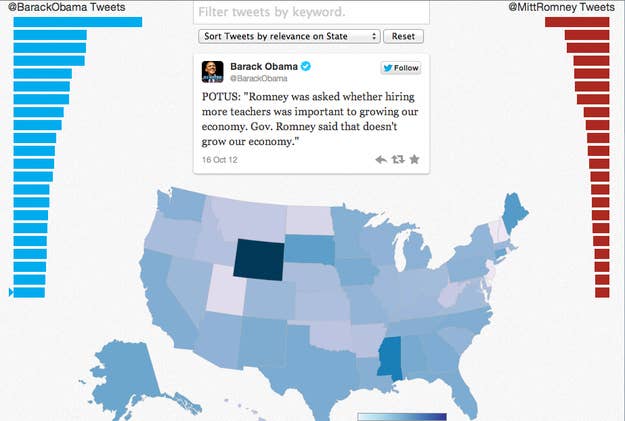
A few months ago, Twitter launched the Twitter Political Index to some fanfare, hyped for its ability to check the pulse of millions of actual people and how they feel about Barack Obama and Mitt Romney with real-time sentiment analysis. But the Twindex's once-a-day score has fizzled as a metric that people actually talk about — the cable news talking heads don't start the morning with a rundown on how Obama's faring according to the latest report. And so the report has failed at what appeared to be its primary reason for existing: to make Twitter not just where the political conversation is happening, but a part of that conversation.
Twitter's election map is in some ways an attempt to reboot that — a last-minute bid to get in on the election conversation before it's over. It provides a state-by-state breakdown of the engagement level of tweets from Obama's and Romney's Twitter accounts. It's highly visual and easy to use. So I can quickly see that this tweet from Obama, about women and health care, had intense engagement in Oregon, but not so much in South Carolina. Or that this tweet from Romney, promising to create wealth and not redistribute it, saw a lot of engagement in Utah and Iowa, but not much in California. The clear point of the election map, and the Twindex before it, is to make Twitter not just a platform for conversation, but very much a part of it. A thing talked about, not just talked through.
If that sounds weird, it's because Twitter is in weird place right now as it attempts to transform from an "Internet" company into a full-fledged media company, its fits and starts marked by tensions with third-party developers and competing services and ever more media-centric layouts.
In the last couple of years, Twitter made a very specific and deliberate choice not to be simply a neutral, real-time cloud API company, but a media company. Media companies have voices. They don't just carry conversations, they create them. It's perhaps nonetheless slightly jarring to see something that most people still consider to simply be a neutral(ish) platform start to come alive, its muscles start to twitch. Tumblr is going through a similar transformation now, though it's manifested as actually hiring reporters to produce native content — even as it hosts, for instance, Gawker Media during its post-Sandy crisis.
Twitter has to take more care, though, as much it desires to be more than just a platform that everybody else rides on, because its value, ultimately, is in its users. Without them, it has none. Even its gentle attempts to break into the conversation are literally powered by its users. Still, what happens when the megaphone starts to speak for itself? Can it say anything? Well, we're going to find out.
